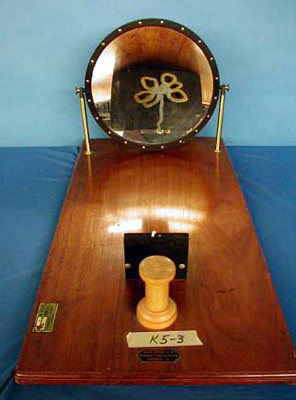Demos: 7A-10 Reflections from Spherical Mirrors

Images formed in spherical mirrors are demonstrated using both the lens board apparatus and actual three-dimensional mirrors.
Directions: (a) For the lens board portion of this demo, refer to the Klinger pamphlet for details of the set-up. The two beams from the slit lamps cross at a point where the object is located. (This causes the rays to diverge from the object point.) Place the object point outside of the focal point, near the focal point and inside the focal point. Virtual images cannot, of course, be seen, but their location can be inferred by noting the “origin” of the diverging rays.
(b) Two large spherical mirrors, one convex and the other concave, can illustrate a number of facts about plane mirrors. First, take the concave mirror and hold it fairly close to your face. Let the class see the reflection. It will be greatly magnified. Face the convex mirror toward the class and point out the use of such mirrors in department stores as security devices, etc.
(c) Finally, turn on the U-shaped neon lamp and move it back and forth around the focal point of the concave mirror. You will need to position it so that a portion of the class can observe the real image moving back and forth. Then move it so that the next portion of the class can see it, and so forth.
Suggestions for Presentation: (a) Point out that a real object point is one from which light rays diverge. By having the two rays from the slit lamps cross at the object point, you have fulfilled this requirement.
(b) Point out that the convex mirror always gives a virtual image (because the light rays cannot converge), smaller than the object. This makes the mirror ideal for wide-angle viewing. Discuss the phrase “Warning! Objects in the mirror are larger than they appear!” What does this mean?
The concave mirror (a shaving or make-up mirror) shows an enlarged virtual image, but the object has to be inside the focal point for this to happen.
(c) This demo is a real eye-opener! Students often don’t really believe that a real image is “hanging” out in space and can be seen there. The moving image of the neon filament dramatically shows that the real image is indeed there.
Applications: There are many applications of spherical mirrors: shaving and make-up mirrors, security mirrors, passenger-side outside mirrors and searchlights.
Last Updated: Nov 30, 2023 11:25 AM